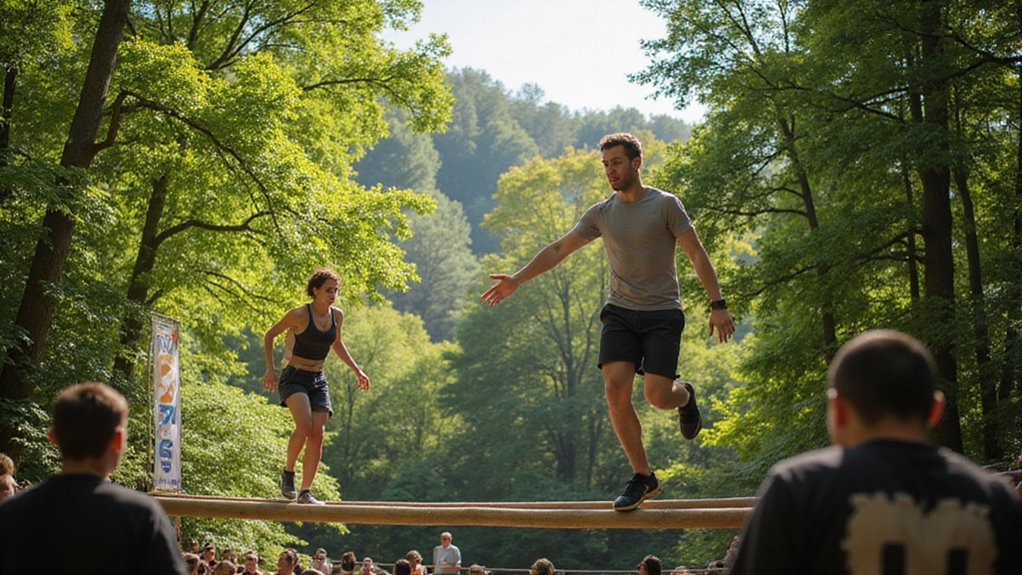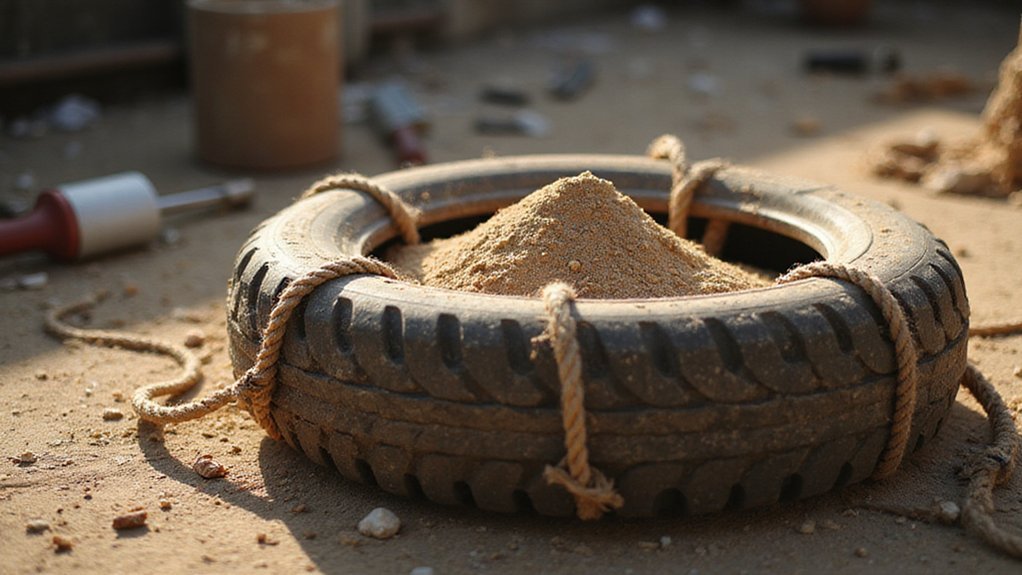Disclaimer: This content is for informational purposes only and does not replace professional medical advice, diagnosis, or treatment. Always consult a qualified healthcare provider before beginning any new exercise program.
Have you ever considered the transformative power hidden within a simple balance beam? Balance Beam Battles represent more than just physical challenges; they’re strategic developmental experiences that cultivate spatial awareness and motor skill precision. You’ll discover how these carefully designed tightrope environments engage children’s natural curiosity while systematically building confidence through structured movement exercises. As you explore these innovative play concepts, you’ll uncover a nuanced approach to childhood physical education that transcends traditional playground dynamics.
Key Takeaways
- Design multi-terrain balance challenges using non-slip polyurethane stones that support weights up to 440 lbs for simultaneous multi-user engagement.
- Create adaptive obstacle courses integrating height variations, interactive activities, and skill-progression elements for both indoor and outdoor environments.
- Implement strategic gameplay strategies that combine physical coordination challenges with cognitive development, fostering motor skills and spatial awareness.
- Utilize lightweight, waterproof balance beam equipment that enables quick reconfiguration and supports safe navigation across diverse play surfaces.
- Track progress through visualization techniques like milestone charts, prizes, and celebration strategies that motivate continued skill development and friendly competition.
Safety First: Understanding Balance Beam Equipment

When it comes to children’s play equipment, safety isn’t just a feature—it’s a fundamental requirement. Kids love balance beam challenges, but you’ll want equipment that prioritizes safety first. The upgraded balance beams offer remarkable protection through intelligent design. Their non-toxic polyurethane construction guarantees durability while maintaining a child-friendly environment. You’ll feel free to let children explore movement with confidence, knowing the maximum weight capacity supports multiple simultaneous users. Non-slip silicone edges and textured surfaces provide critical stability across diverse terrains—from carpet to grass, hardwood to tile. The lightweight, waterproof design simplifies setup and maintenance, allowing parents and educators to create secure play spaces effortlessly. Understanding these safety characteristics transforms balance beam equipment from a simple toy into a sophisticated developmental tool.
Setting Up Your Indoor Balance Challenge Arena

Armed with thorough knowledge of safety features, parents and educators can now strategically design indoor balance challenge arenas that transform physical play into developmental opportunities. You’ll want to use lightweight, stackable balance beam stepping stones on non-slip surfaces like carpet or tile, creating dynamic pathways that challenge coordination and cognitive skills. Carefully position the stones to construct navigable routes that adapt to children’s growing abilities, ensuring each configuration promotes progressive learning.
Incorporate educational elements by transforming these stones into interactive learning tools. Use them for counting exercises, color recognition challenges, or stacking activities that simultaneously enhance physical and mental development. The waterproof surfaces allow for easy cleaning with a wet towel, maintaining a hygienic play environment that supports continuous skill advancement through engaging, dynamic challenges.
Outdoor Balance Adventure Zones for Kids

Because outdoor environments offer dynamic and unpredictable terrain, balance beam stepping stones provide an ideal platform for developing children’s motor skills and spatial awareness. These versatile adventure zones transform ordinary spaces into engaging learning landscapes that challenge physical capabilities.
Balance beam benefits emerge through strategic outdoor play configurations:
- Non-slip polyurethane stones enable safe navigation across diverse surfaces, supporting coordination development
- Lightweight design allows rapid course reconfiguration, encouraging creative problem-solving and adaptability
- Maximum weight capacity of 440 lbs accommodates multiple children simultaneously, promoting collaborative skill-building
Children’s outdoor balance challenges transcend mere physical activity, serving as sophisticated developmental tools. By strategically arranging waterproof stepping stones across grass, tile, or hardwood, parents and educators can create multi-dimensional learning environments that simultaneously test and enhance children’s proprioceptive skills with scientific precision.
Creative Gameplay Strategies for Tightrope Mastery

While traditional balance beam training often emphasizes repetitive linear movements, innovative gameplay strategies can transform tightrope mastery into a dynamic, multisensory learning experience. By integrating creative challenges, you’ll engage children in skill progression through strategic obstacle courses and interactive activities. Stack stones to create varied beam heights, challenging participants across different skill levels and age groups.
Implement group activities that combine physical coordination with cognitive development, such as color recognition and counting games on the balance beams. Time-based competitions foster a friendly competitive spirit, allowing kids to track their improvement and build confidence. The non-slip textured surfaces guarantee safety, enabling children to focus entirely on mastering complex balancing techniques while enjoying an engaging, educational environment that promotes holistic physical and mental growth.
Developing Essential Motor Skills Through Play

When children engage with balance beam stepping stones, they unfasten a sophisticated pathway to motor skill development that transcends traditional physical education approaches. These innovative play tools transform learning into an immersive experience where motor skill acquisition becomes a dynamic, interactive process.
The strategic engagement with balance beam stepping stones promotes:
- Proprioceptive awareness through spatial navigation challenges
- Balance and coordination refinement via obstacle course creativity
- Kinesthetic intelligence development through playful learning environments
Age-Appropriate Balance Beam Techniques
Three critical developmental stages define the approach to balance beam techniques for children, each meticulously tailored to optimize motor skill progression and cognitive engagement. Young learners aged 3-5 begin with fundamental balance techniques, mastering heel-to-toe walking that establishes foundational spatial awareness. As children progress into the 6-8 age range, their skill progression advances through more complex movements like side-stepping and backward walking, which challenge their emerging motor capabilities and build confidence.
Tracking Progress and Celebrating Movement Milestones
As children master age-appropriate balance beam techniques, documenting their kinetic development becomes a strategic approach to understanding motor skill progression. Milestone motivation emerges through systematic visual tracking of physical achievements.
- Progress Journaling: Record specific movement accomplishments, including successful balance beam crossings and duration of balance maintenance, creating a thorough documentation of skill evolution.
- Celebration Strategies: Implement reward mechanisms like stickers, certificates, or personalized prizes that validate individual performance and encourage continued skill development.
- Motivational Visualization: Design progress charts that graphically represent skill milestones, fostering healthy competition and providing tangible evidence of kinesthetic improvement.
Frequently Asked Questions
What Is the Hardest Skill on Balance Beam?
You’ll find the aerial dismount the hardest skill, requiring precise dismount techniques, complex balance exercises, and mastering common errors. Your mental focus and physical control determine success, making it a pinnacle of gymnastic challenge.
How Can I Make My Balance Beam More Challenging?
Did you know 87% of athletes improve balance through strategic training? You’ll elevate your skills by incorporating advanced beam techniques, creative beam exercises, and challenging balance beam obstacles that test spatial awareness and muscular control.
Why Don’t Men Compete Balance Beam?
You’ll find men’s absence from balance beam competitions stems from historical gender dynamics in sports, where competitive norms traditionally assigned graceful, precision-based events to female athletes, reflecting broader cultural perceptions of athletic categorization.
Why Do Gymnasts Wave Their Arms on the Balance Beam?
You’ll gracefully navigate precarious terrain by artfully deploying arm positioning techniques, transforming balance beam choreography into a mesmerizing display of gymnast arm movements that stabilize, communicate, and elevate your athletic performance.
Conclusion
Balance beam challenges aren’t just physical exercises—they’re metaphorical bridges between limitation and potential. Each step you take represents personal growth, transforming uncertain terrain into a pathway of self-discovery. By conquering these carefully designed obstacles, you’re not merely maneuvering a beam, but constructing resilience, spatial awareness, and confidence. Your journey symbolizes life’s delicate balance: steady, purposeful, and ever-evolving through calculated risk and measured courage.



